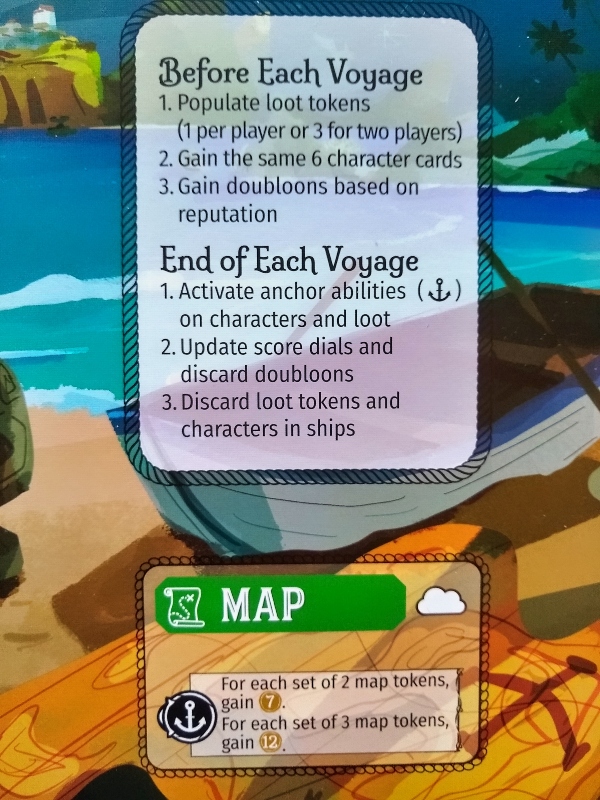A recent post in the Board Game Design Lab group on Facebook asked, “What kind of information should you print on the board?” The question came from a designer who was considering whether to print a copy of key rules on the board.
Some great boards
My favorite boards, such as the Tapestry board above, generally do not include much rule content. Jamey used symbols, including meta-symbols, to display an extraordinary amount of information without using tons of words that require reading. Scythe is another great example of this, as are most Stonemaier games.
An interesting exception is the board of Libertalia: Winds of Galecrest, which displays the before/end-of-voyage rules as well as the effect for each loot token. Viticulture is another exception, as its board summarizes key rules for the different phases of the year. In contrast, Stonemaier’s typical practice is to avoid rounds/phases. Such complications can impair the fast pace/smooth flow that’s a hallmark of Stonemaier games. In addition, such complications require the players to step out of the theme, mentally, and remember that they are playing a game that requires some upkeep. And, actually remembering these complications can impede learning and retention, which is also an important point in Stonemaier games.


Putting end-of-round rules on the gameboard can ameliorate these issues. I’ve been playing Viticulture for over a year, and I still need the end-of-year reference every game. I played Libertalia: Galecrest for the first time this week, and I expect that I’ll need the reminders for that game, too. In such cases, putting the relevant rules on the board makes perfect sense.
Libertalia’s board also shows loot effects. These could have been printed on cards, and players could have taken these cards when acquiring loot thereby providing a handy reference. But the cards would have taken more square footage, and Jamey wouldn’t have gotten his cool tactile components. A compromise would have been to put the loot effects on a reference card for each player. They did this by providing some heavy chipboard cards that also could be drawn during setup, which might have been overkill vs cardstock.
General procedure
Other than end-of-round rules, what other information belongs on a board?
My standard procedure starts with finding 3-4 games with similar mechanics, focusing in on games that I like the most in terms of usability and aesthetics, then drawing general conclusions from those examples. This is the procedure that I used to answer the designer on Facebook.
From that standpoint, my favorite relevant boards might be Tapestry, Scythe, LOTR Journeys, and Waterdeep. None of them have tiny little text like that to summarize rounds/phases. The boards have less “whitespace” than the one initially posted on Facebook for the designer’s game, yet they’re not particularly small — i.e., the publishers have kept the boards as small as possible, which helps to constrain price (and increase the range of tables that the game actually fits upon).
The designer’s game required little slots for placing things. In addition to the Waterdeep board, I recommended that he look at the player mats of Scythe. Both of these exemplify the allocation of little slots for placing things (Waterdeep buildings and Scythe mechs) atop illustrations. Note the semi-opaque shapes on the board/mats. These are somewhat analogous to the apparent spaces on the designer’s board for placing some sort of tiles.
I also noted that the designer might entirely question the need for a board altogether, as the spots on the designer’s board looked like slots for placing modular groups of hexes. He could consider whether his situation is different from that of LOTR: Journeys, which has only the tile modular board, and nothing beneath it. Note in the setup how they guide players to properly assemble the board. Does the situation differ enough from LOTR to require a board? It depends on the mechanics.
Finally, I started with Tapestry as an example because it has a scoring track and a map area, both of which also came up in the designer’s post. I had hoped it would give him ideas for representing high scores (e.g., those 100x 200x etc slots on the Tapestry board).
Notes to self
- A quick glance at “10 Boards [sic] Games That Have Gorgeous Boards”
- None of the photos appear to show any rules on any of the boards
- Might have been cropped out, of course
- Avoid rounds/phases
- Impact on players
- Impact on board aesthetics
- What other kinds of rules routinely appear on boards?
- e.g., Pandemic summarizes entire Order of Play
- e.g., Libertalia: Galecrest shows loot tile effects
- Why not use reference cards instead?
- How often do players take time to pull out ref cards instead of just playing the way they think they should be played?
- Rules can’t be printed easily on modular boards except on certain modules that always appear every game
